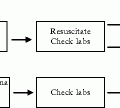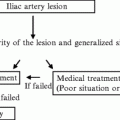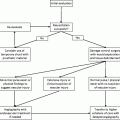Fig. 30.1
SVC stenosis
4.
Mediastinal fibrosis due to infectious processes or radiation—Nonmalignant etiologies include infectious processes such as tuberculosis and radiation-induced mediastinal fibrosis.
2.5 Diagnosis
Patients with SVCS present with signs of venous occlusion of the head, neck, upper thorax, and arms. Dyspnea is common as edema impinges on the larynx and pharynx. Additional sighs include face and neck swelling, cough, dysphagia, plethora, distended veins in upper thorax, neck and arms, and upper limb edema. Cerebral edema may also result, leading to mental status changes, headache and lightheadedness.
Symptoms present gradually with progressing intensity as neoplasms increase in size and invasiveness, resulting in increasing obstruction. Though the overall course is that of worsening symptoms, patients may experience intermittent improvement of symptoms as venous collaterals develop. Histological diagnoses are not necessary to diagnose SVCS, although they can be valuable in distinguishing malignant from benign etiologies. A tissue diagnosis may be necessary for patients who present with SVCS without a prior diagnosis of a neoplasm. In such cases, minimally invasive techniques such as sputum cytology and biopsy of enlarged peripheral lymph nodes are preferred. More invasive techniques such as bronchoscopy, VATS, thoracotomy, and mediastinoscopy may be necessary to diagnose subtypes of lymphoma. Suspected non-Hodgkin lymphoma and small cell lung cancers can be diagnosed and staged with bone marrow biopsies.
2.6 Diagnostic Imaging
Chest radiograph: Most patients with SVCS have an abnormal chest radiograph reflecting the underlying neoplastic etiology. The most common findings on chest X-ray are mediastinal widening followed by pleural effusion.
Contrast-enhanced computed tomography angiography (CTA): CTA of the chest and neck with particular focus on the venous structure represent the most useful study for SVCS as it is able to define the underlying cause of venous obstruction, identify the extent of occlusion, and evaluate any collateral venous drainage pathways. Identification of venous collaterals is a sound indicator for SVCS (specificity 96%, sensitivity 92%).
Magnetic resonance venography (MRV): This is an alternative imaging modality to CT scan for patients who cannot receive contrast administration due to allergy or suffer from CT scanning-associated claustrophobia.
Diagnostic Venography: This imaging modality requires catheter placement from either femoral or upper extremity venous system to identify underlying SVC pathology. It offers the advantage of concomitant endovascular intervention such as venous stenting at the time of diagnostic imaging. Venography of the upper limbs bilaterally is the gold standard for identifying SVC obstruction and delineating the extent of thrombus formation. However, unlike CT scans, conventional venography is unable to identify the cause of the SVC obstruction unless thrombosis is the exclusive etiology.
2.7 Management
Symptomatic SVCS should be approached as a clinical emergency. Immediate therapy includes head elevation and steroid administration to reduce edema and compressive symptoms.
Indications for treatment:
1.
Symptomatic disease
(a)
Chronic or recurrent SVC nonmalignant obstruction: consider operative or endovascular interventions
(b)
Acute severe malignant SVCS: chemoradiation therapy to achieve initial tumor response followed by operative or endovascular therapy.
2.
Asymptomatic disease: is not an indication for treatment.
2.8 Open Operative Choices
For malignant tumor, consider surgical treatment with tumor resection via mediastinotomy and SVC bypass. Prosthetic bypass conduit with Dacron or expanded polytetrafluoroethylene (ePTFE) graft can be used for SVC bypass. Autogenous bypass conduit with jugular vein or femoral vein interposition graft can also be used. Due to potential vein graft diameter mismatch, large caliber prosthetic graft is more commonly used compared to autogenous vein graft conduit. However to reduce the size mismatch, spiral vein grafts are used.
2.9 Endovascular Interventions
Stay updated, free articles. Join our Telegram channel

Full access? Get Clinical Tree







